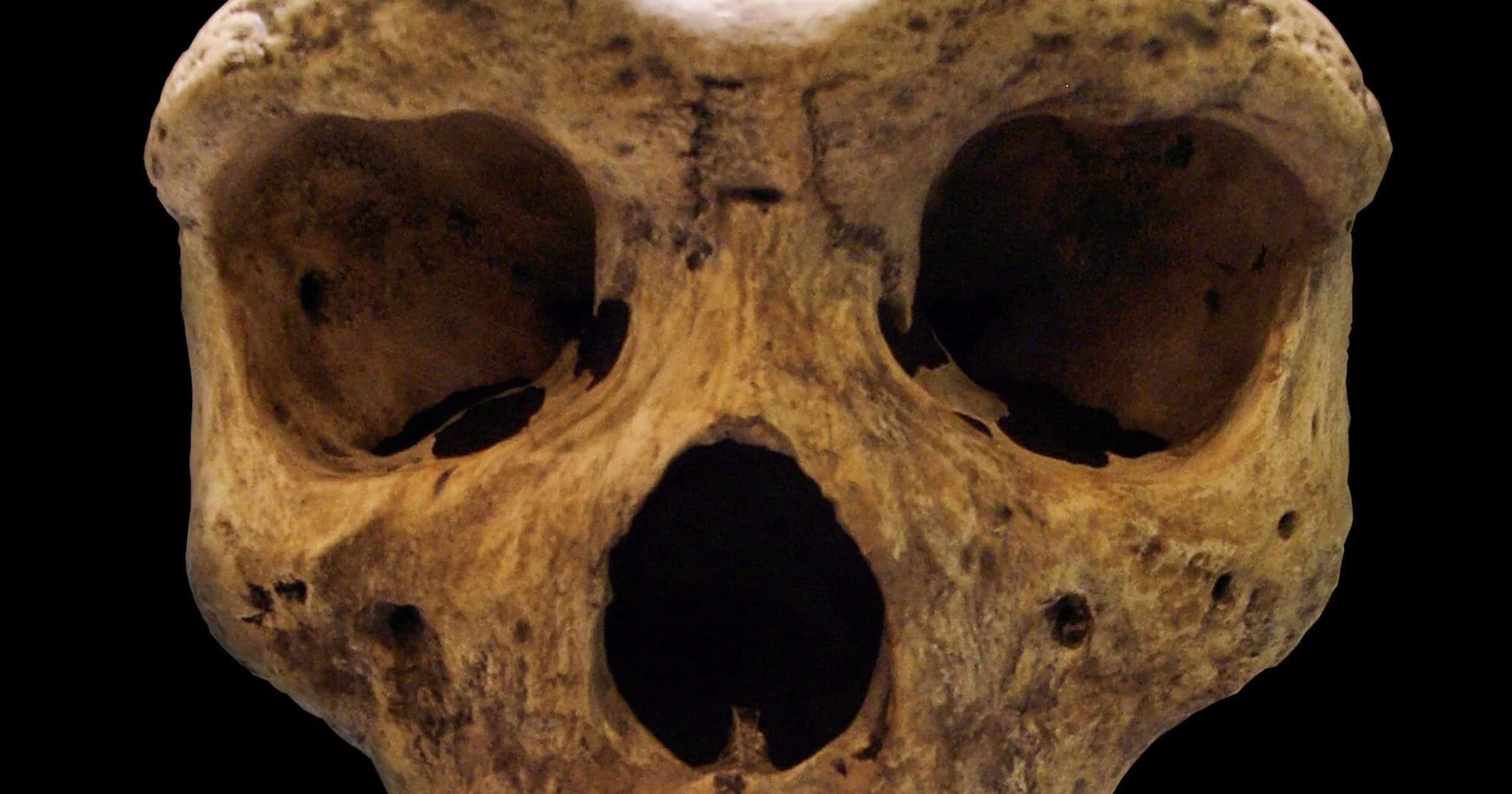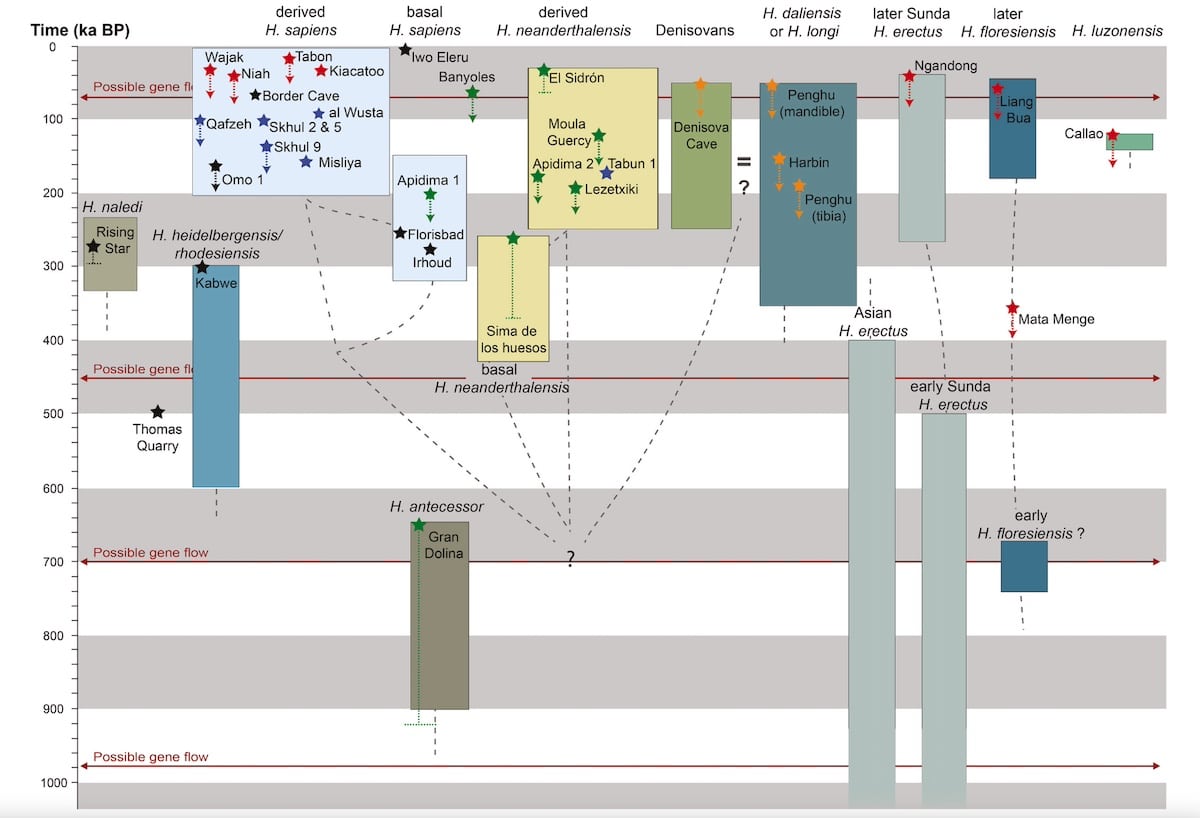 Human Origins
Human Origins
 Paleontology
Paleontology
Fossil Friday: New Dating of Pleistocene Fossils Rewrites the Story of Human Evolution

This Fossil Friday features a replica of the famous Broken Hill cranium (Kabwe 1) of Homo rhodesiensis, which was found in 1921 in a metal mining quarry in Zambia and was often considered to be an archaic ancestor of modern humans. The dating of this skull, and hundreds of other Homo fossils from Africa, Europe, Asia, and Oceania, was recently revised in a ground-breaking new study titled “Direct dating of human fossils and the ever-changing story of human evolution” by Grün & Stringer (2023), which represents an updated follow-up study to the previous work of Grün (2006).
What, Yet Another Rewriting?
Actually the study represents the summation of 37 years of collaborative research. Media reports about this impressive new study unsurprisingly featured headlines like “Recent fossil dating techniques change our ideas of the human evolution timeline” (NHM 2023) or “A new look at some old fossils has just rewritten the story of human evolution” (Spalding 2023). Why do we see such headlines over and over again? It is often claimed that the theory of evolution is as well established as the theory of gravity. When did you last see a headline like “New experiment rewrites the story of gravity“?
That said, the very extensive new study by the distinguished paleoanthropologists Rainer Grün and Chris Stringer undoubtedly produced several very important results:
- The authors reviewed the dating of all major finds of fossil Homo from the past one million years, and critically discuss the U-series and ESR dating with special emphasis to different sources of errors such as leaching and overprinting. “The problem with bone is that it’s an open system. Uranium can get into the bone, allowing it to be dated, but more can also be added or washed out over time” said Professor Chris Stringer in the press release (NHM 2023). The scientists found that for some sites “the direct dates obtained do not fit the age estimates using other methods” and “in some cases the direct dates discussed here have challenged conventional thinking in palaeoanthropology.”
- They re-dated the earliest occurrences of Homo sapiens in Africa, the Levant and Europe, and confirm that “if Apidima 1 is indeed a H. sapiens, it documents the earliest known presence of our species in Eurasia with an estimated age of about 211 thousand years, while the Misliya cave material from Israel “still represents the earliest known derived H. sapiens in the Levant” with an age of 152 thousand years”. Both dates are much earlier than the traditional Out-of-Africa scenario would predict to find. The press release by the Natural History Museum says “The existence of early Homo sapiens in Europe was over 150,000 years earlier than first thought” (NHM 2023).
- The authors also discussed the more recently described human species of Homo floresiensis, H. luzonensis, H. naledi, and H. longi. They found an age of 134 thousand years for Homo luzonensis, refuting younger datings of only about 65 thousand years that were apparently distorted by secondary U-overprints. They also mention that skeletal characteristics led to a very incorrect initial age estimate for Homo naledi, four times older than the later radiometric dating, and said that “it may be worth mentioning that the postulated “morphological clock” was out by 1.35 million years for H. floresiensis”. Another example of Darwinian reasoning that massively failed the empirical test.
- Finally, they provided an updated summary of our present understanding of human evolution, with remarkable admissions such as the “co-existence of multiple lineages (in our view, species) over the last 2 million years, with at least 4 of these persisting into the last 100,000 years”, or that studies “show that searching for deep single points of origin for lineages like H. sapiens may ultimately be a futile task.”
The Take-Home Message
However, the most important take-home message is shown in figure 85 of Grün & Stringer (2023), which is based on Galway-Witham et al. (2019) and is featured below. It shows that several different alleged species of the genus Homo lived contemporary in the Pleistocene and experienced various instances of gene flow. This strongly suggests to me and some other critics of the current consensus that all these assumed species are just different populations of a single species Homo sapiens, that at best would qualify as subspecies or geographical races. I will provide a detailed argument for such reclassification in a book-length treatment of archaic Homo that is currently in preparation.
The most recent data on human fossils and their dating do not really support an evolutionary narrative from ape-like ancestors to modern humans, but a gap between ape-like australopithecines and real humans, as well as just a very diverse human species that even featured a greater morphological and genetic diversity in the past than today. Darwin critics with a Biblical perspective may find it interesting that this would resonate quite well with population genetic models based on a first pair with designed heterozygotic diversity and a significant population bottle neck (Sanford et al. 2018, Hössjer & Gauger 2019).

References
- Galway-Witham J, Cole J & Stringer C 2019. Aspects of human physical and behavioural evolution during the last 1 million years. Journal of Quaternary Science 34, 355–378. DOI: https://doi.org/10.1002/jqs.3137
- Grün R 2006. Direct dating of human fossils. American Journal of Physical Anthropology 131(S43), 2–48. DOI: https://doi.org/10.1002/ajpa.20516
- Grün R & Stringer C 2023. Direct dating of human fossils and the ever-changing story of human evolution. Quaternary Science Reviews 322: 108379, 1–109. DOI: https://doi.org/10.1016/j.quascirev.2023.108379
- Hössjer O & Gauger A 2019. A single-couple human origin is possible. BIO-Complexity 2019(1), 1–20. DOI: https://doi.org/10.5048/BIO-C.2019.1
- NHM 2023. Recent fossil dating techniques change our ideas of the human evolution timeline. NHM Press Release December 18, 2023. https://www.nhm.ac.uk/press-office/recent-fossil-dating-techniques-change-our-ideas-of-the-human-ev.html
- Sanford J, Carter R, Brewer W, Baumgardner J, Potter B & Potter J 2018. Adam and Eve, designed diversity, and allele frequencies. pp. 200–216 in: Whitmore JH (ed.). Proceedings of the Eighth International Conference on Creationism. Creation Science Fellowship, Pittsburgh (PA).
- Spalding K 2023. A New Look At Some Old Fossils Has Just Rewritten The Story Of Human Evolution. IFL Science December 20, 2023. https://www.iflscience.com/a-new-look-at-some-old-fossils-has-just-rewritten-the-story-of-human-evolution-72092
